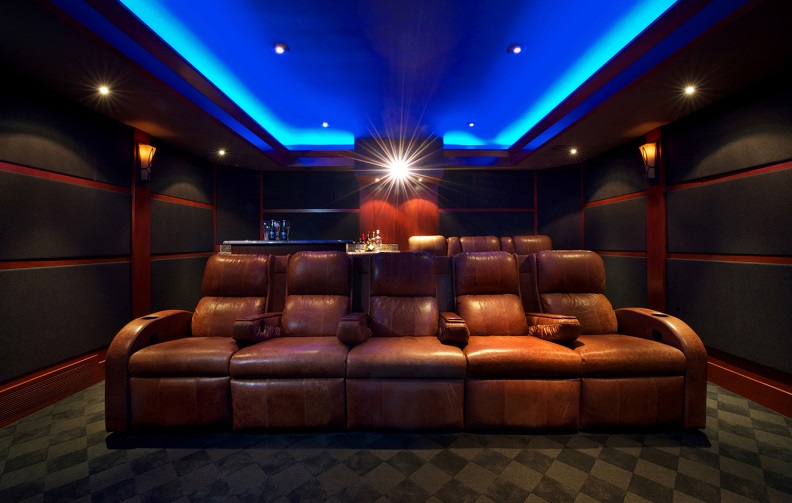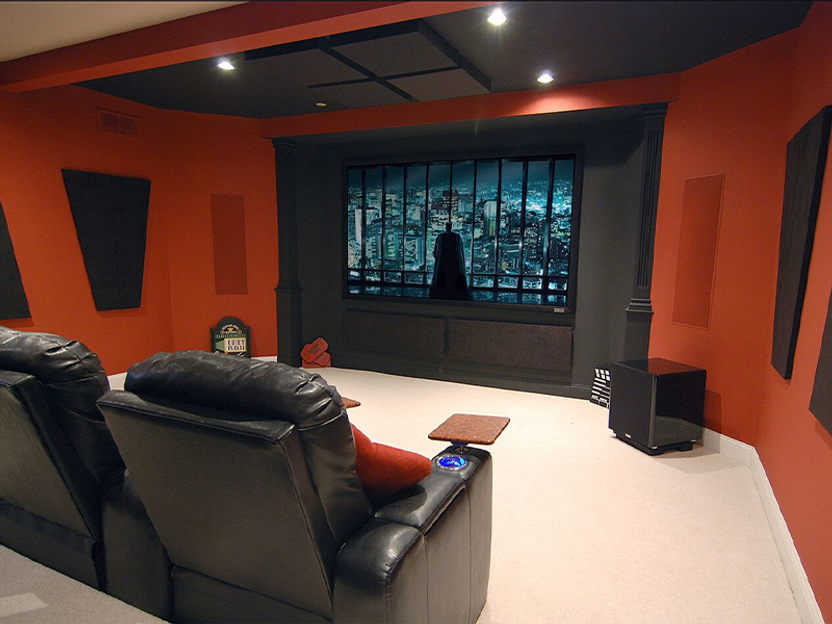The Basics of Home Theater
Posted by Dave Pedigo on 6th Apr 2020
Building a home theater is an exciting and often passion-based project. Creating an environment that recreates movies as the director intended is the benchmark for high-performance home theaters. "As the director intended" may sound arbitrary, it is, in fact, very objective and based on industry standards and best practices. While there are many levels of home theaters, but it doesn't mean that it has to be complicated. With a little bit of research and planning, you can have the home theater experience you have always wanted.
In this post, we are going to talk about general guidelines and rules of thumb. Then, in future postings, we will dig down into the science, engineering, and art of home theater. As with most things in life, a bit of planning upfront will go a long way.
Planning
When planning a theater, most people want to jump directly into selecting the hardware. For example, Greg wants a home theater and decides to buy a projector and screen. When determining what size screen, he says, "my friend has a 100" screen, so let's go a little bigger at 110". While 110" sounds big, it would be better to figure out the viewing angle to determine what the screen size should be. In this example, Greg's couch is a few feet further away, and so while 110" is a bigger screen, it looks smaller than his neighbors. In a future post, we will explain how to figure out the ideal screen size. We can do this because there are standards to reference. While we at Auralex Acoustics have our opinions, we will reference industry standards and best practices as much as possible and keep opinions out of our posts. With unbiased information and planning ahead of time should, Auralex Acoustics strives to help you make the most informed decisions, helping you achieve the best experience possible with the most bang (or boom) for your buck.
The Room
The size, shape, and construction of the room has a tremendous impact on the playback of material, mainly regarding sound quality. While most attribute the quality of the sound directly to the cost of the speakers, this is rarely true. While many factors make some speakers better than others, how soundwaves coming out of the speakers interact with the room is just as, if not more critical, than speaker quality. Designing a home theater is a broad but deep subject. In this article, we will discuss some general topics and will dig deeper in future blogs.
Shape: The room should be rectangular but not too long and narrow. The room should not have concave shapes, but convex shapes are OK. If possible, the room dimensions shouldn't be divisible by each other because of room modes. Auralex will explain room modes in a future article. However, many rooms won't fit these parameters, and luckily, acoustic treatments such as absorbers, diffusers, and bass traps can correct room related problems.
Construction: The build of a home theater, where possible, should be one that is quiet, with a low noise floor, and keeps sound from coming in or going out. These are two distinct but interrelated concepts. Low noise floor means that the room is designed in such a manner that sounds, such as the air moving in a room, is quiet. A low noise floor allows for a wide dynamic range, making it easy to hear whispers and other quiet details.
The next concept is sound isolation, what many call soundproofing. Sound isolation requires specific construction methods to keep outside sounds coming in (ingress) and sounds from inside the room going out (egress). By preventing sound ingress, those watching the movie are much more likely to get pulled into the film and creating the suspension of disbelief. By preventing egress, the likelihood of waking up the baby and having to stop the movie is lessened. Sound isolation requires significant planning, but when executed correctly, the results are amazing. It is important to note that sound-isolating a room does not translate to the quality of the sound in the home theater. Sound isolation improves the noise floor and remove distractions while enjoying a movie.

The chair: Sometimes referred to as the money seat, the king seat, or the primary listening/viewing position. Believe it or not, this is one of the most critical data points when designing a home theater. Before explaining why it is essential to understand that all seats in a home theater should be very good seats, and the better the designer, the more likely this is to occur. That said, you need a starting point. In Figure 1, you can see how important the position of the chair (couch in this case) is for speaker placement. One central location is required to determine where each speaker should go, based on industry standards. As a quick aside, this is a challenging room, which is an excellent example of why home theaters always requires compromise. The primary seating position also determines the size of the screen. For example, if you sit 10 feet back (as shown in Figure 1) and the owner prefers a 40° field of view (THX specification and also about 2/3rds back in a commercial theater), the right sized screen is 87" wide. These distances, from the screen and speakers, then determine what speakers to use, in combination with which amplifier, how bright your projector should be etc.
Sound Treatment: Regardless of whether the content is from a movie or music, the sound coming out of a speaker is energy. This energy transmits as sound waves, which travels at approximately 343m (1,125 feet) per second (this varies based on altitude and temperature). Even in the biggest of home theaters, the room is still a small room from an acoustics perspective. As such, the sound waves coming from the speakers and subwoofers bounce all around the room multiple times. The bouncing of sound waves is called reflections. Too many reflections cause distortion and reduced fidelity. By using acoustic treatments, comprised of absorption, diffusion, and bass trapping, reflections are controlled, creating a superior acoustic experience. By treating a room properly, a home theater can perform incredibly well, even with less expensive equipment. In future posts, we will explain exactly how each of the three main categories work and how they impact sound quality.
Hardware: As stated above, buying home theater equipment is usually the most exciting part for many home theater enthusiasts. It is also the most expensive and most confusing. Unfortunately, marketing materials vary from manufacturer to manufacturer, and it is difficult for most know what you are getting. This is typically due to a lack of independent testing.
The best example of misleading performance claims is projector contrast ratio specifications. Many projector manufacturers claim their product has an astounding ∞:1 or 1,000,000:1 contrast ratio, which is not possible when tested to industry standards. In studies completed by the AVIXA, a global AV Trade Association, just achieving a 150:1 contrast ratio is very difficult. In fact, in AVIXA's standard PISCR (Projected Image System Contrast Ratio), the highest category of contrast ratios is 80:1. An 80:1 contrast ratio with a projector and screen means all critical details are visible on the screen.
The reason for the above example is to show that marketing is difficult to interpret. Whenever possible, buy hardware from manufacturers that provide independent laboratory certifications or test data, such as Underwriters Laboratories, THX Ltd., and Riverbank Acoustical Laboratories. Hardware selection for home theaters is a topic that can run down many rabbit holes, so for now, here are a few hints.
Speakers: Look for speakers that have a relatively flat frequency response (±3dB 80 Hz – 20,000 Hz), are reasonably efficient (LCR should be at least 89 dB, surrounds can be 87 dB), and have appropriate power handling capabilities (meaning the speakers can handle enough power to hit reference level). Reference level means the speakers can hit 105 dB for peak scenes at the primary listening position. The speakers should also have a high build quality and reputation to last.
Subwoofers: Subwoofers are very similar to speakers, in that you should be able to hit reference level, which is twice as loud as front and surround speakers, at 115 dB peak at the primary listening position. The subwoofer should also have a relatively flat frequency response and play from 20 Hz to 125 Hz without distortion. It is highly, highly recommended that all homeowners consider using two subwoofers instead of one. Multiple subwoofers are significantly better at providing smooth bass across all seats as compared to a single subwoofer. Two $500 subwoofers will provide more uniform bass coverage, and a better experience, than one $1,000 subwoofer. If you are interested in why you should use two or four subwoofers, download CTA/CEDIA CEB-22 Home Theater Recommended Practice and read pages 32 – 38. Two of the leading electronics trade associations co-authored the CEB-22: The Consumer Technology Association (CTA) and CEDIA.
Projector and screen: In this instance, we are referring to 2-piece projectors, meaning there is a projector and a separate screen. We won't go into great details here, but will in the future. The image coming off the screen should be a minimum of 27 foot-Lambers. What this means is the projector should be twice as bright as a commercial theater projector. The increased brightness is due to consumer-grade projector lamps dimming quickly compared to commercial lamps. Increased lamp output ensures the image is as bright as a commercial theater for the duration of the lamp. Other considerations include ensuring the projector is at minimum HDMI 2.0 capable. High Dynamic Range (HDR) is just starting to come onboard with projectors, as it is much harder to achieve than with a flat panel, but HDR-10 is undoubtedly a bonus. Also, be sure to buy a reputable projector screen. The most significant area where screens vary is in their white field uniformity. The better the white screen uniformity, the more even a white image is on the screen. While this may not sound like a big issue, once you notice a picture isn't uniform, you cannot unsee it.
Calibration: Finally, once all the equipment has been installed, including acoustic treatments, its time to calibrate the equipment. A reasonable question to ask is, "why do I need to calibrate if the room is properly designed and the right equipment is purchased and installed?". The answer is because the equipment needs fine-tuning to meet the conditions of the room and installation. Calibration enhances the performance of the equipment, and the magic of the details come alive.
A good analogy for calibration is Formula 1 racing. While a single Formula 1 car can cost millions of dollars, the cars must be adjusted to meet the conditions of the track where they are racing. And so, calibrating a home theater tunes each piece of hardware to its particular room conditions. The process of calibrating a home theater can require just a few adjustments or be an extensive and precise process depending on the demands of the customer. However, the benefits of even a simple calibration, such as setting the sound pressure levels of the speakers or the brightness and contrast of a television, will show immediate results.

Conclusion
Auralex Acoustics aims to provide an unbiased approach to helping homeowners build the theater of their dreams. Home Theater design is like putting a puzzle together, there are many individual pieces, each of which is equally important in creating a complete experience. Incorporating acoustic treatments in a home theater is a vital piece of the puzzle. Auralex Acoustics has spent over 30 years in manufacturing and selling best in class acoustic treatments that maximize the acoustic performance of theaters across the globe. If you have any questions or need assistance, please feel free to contact Auralex support@auralex.com or +1 (800) 959-3343.


